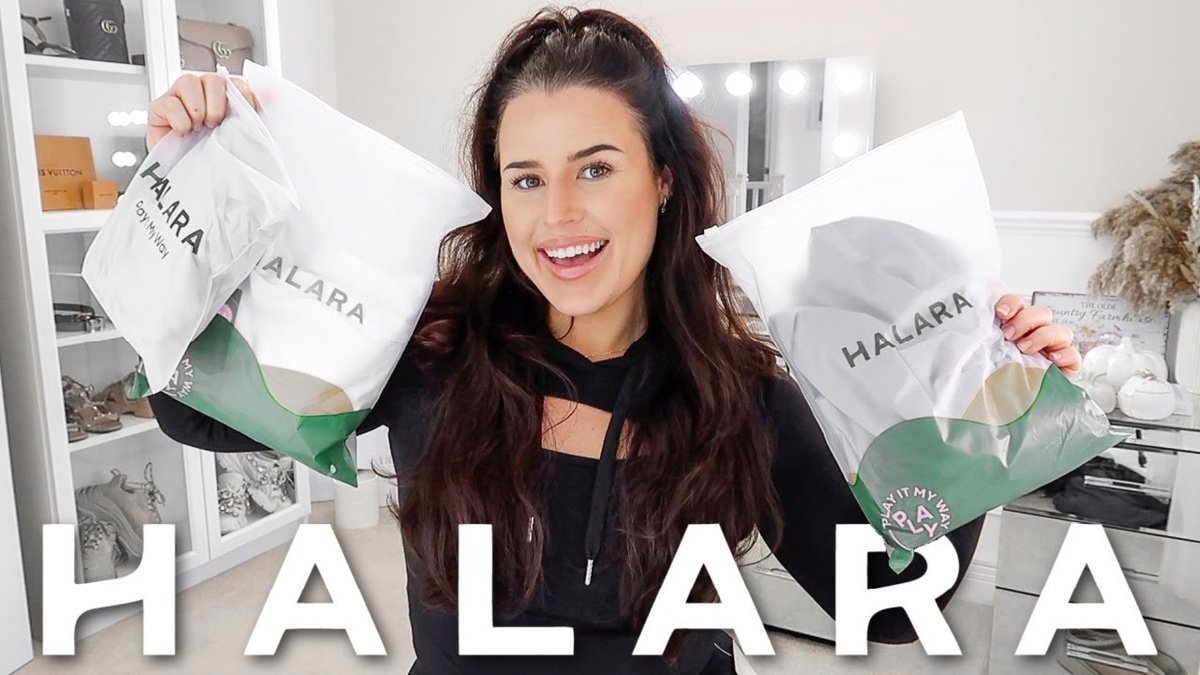
Halara is a brand known for offering trendy and affordable activewear, athleisure, and casual fashion pieces that appeal to people who want stylish workout and lounge clothing without spending a premium.
Their product lineup includes leggings, yoga pants, skorts, sports bras, moisture-wicking tops, casual dresses or loungewear, and accessories. Halara often uses synthetic fabrics like polyester, nylon, spandex, and elastane blends—materials chosen for stretch, comfort, and quick drying. Because the price point is relatively low, many see Halara as accessible and inclusive in terms of style and sizing.
But what does that mean when we ask, Is Halara sustainable? If we focus only on material choices, durability, production quantities, and brand transparency, there are strengths and weaknesses:
Strengths:
- The synthetic blends used in many Halara pieces are durable and retain stretch, which can help garments last through frequent use.
- Their pricing and design strategy allow more people to access fashionable activewear; for many, that means more use per dollar, which is one part of sustainability.
- Their “affordable activewear” model encourages people to try styles or get comfortable with fitness wear without a huge investment.
What Other Alternative Brands Offer
If you’re looking for activewear or athleisure brands that do better (or differently) with materials, design integrity, durability, and transparency — here are several alternatives that are more focused on sustainable or “responsible” practices. These may have higher prices, but they often bring benefits in terms of material quality, durability, and less waste in design.
| Brand | What They Do Differently / Stand Out Features |
|---|
| Tentree company | Uses recycled or organic materials (organic cotton, recycled polyester, Tencel lyocell). Also has nature-focused goals like planting trees per purchase. |
| Alternative Apparel | Known for comfortable basics made with organic cotton and recycled polyester; soft finishes and low-impact dyes. They also tend to avoid overly fast trend cycles. |
| Prana yoga | Offers activewear made with organic cotton, recycled materials, with designs that focus on longevity & function. |
| Girlfriend Collective | Uses high proportions of recycled materials, often packaging and fabrics made from post-consumer waste like plastic bottles or fishing nets. Also has programs for taking back worn garments. |
| Iron Roots | Focused on natural fibers (hemp, organic cotton, TENCEL), trying to reduce synthetic usage, and design pieces that are durable. |
What Does Halara Offer?
Before analysing sustainability, it helps to understand Halara’s product range, style, and appeal.
- Product Types & Styles
Halara primarily offers women’s activewear, athleisure, and casual apparel. This includes:- Leggings, yoga pants, and sweatpants
- Sports bras, tops, moisture-wicking / workout tops
- Dresses, skorts (skirts with built-in shorts), casual dresses, loungewear
- Outerwear / casual jackets, plus accessories like socks, headbands.
- Design Features & Fit
- Inclusive sizing—Halara tends to provide extended size ranges so more body types are catered to.
- Fashion & trends: The designs are on-trend, often blending functionality (for workouts or active lifestyle) with street or casual style. Many items are designed to “transition” from workout to everyday wear.
- Features such as stretch, moisture‐wicking, breathability are highlighted in categories like activewear.
- Pricing & Market Position
- Halara positions itself as an affordable activewear / athleisure brand. You get fashion, functional design, and trendy styles without premium brand pricing.
- It sells direct-to-consumer via e-commerce platforms. Marketing is heavy via social media, influencer-led, etc. Viral ads, frequent new styles.
- Brand Identity & Values (Stated)
- Halara claims to aim for inclusive fashion, combining style, comfort, and some sustainability.
- They have a “Sustainability” section on their website. Some suppliers are claimed to be using alternative energy, etc.
So, what’s on offer is appealing: trendy, affordable, inclusive, designed for active or casual lifestyles. Now, how sustainable is Halara given what it does and claims?
Is Halara Sustainable?
To answer this properly, we need to examine Halara across several sustainability criteria: materials, labor / ethical practices, environmental and waste management, transparency, and the overall business model.
Materials & Fabric Use
- Predominantly synthetic fabrics: Halara’s clothes often use polyester, nylon, spandex, elastane blends—common in activewear because of stretch, moisture management. However, these materials have known environmental issues: high energy input, derived from fossil fuels, shed microplastics, non-biodegradable.
- Some use of natural or recycled fibers: Halara claims in some product lines to use recycled polyester, organic cotton, etc. But these are not universal, and there is limited evidence of wide adoption or strong certification.
- Certifications: There is mention that “some” suppliers are certified by entities such as WRAP (Worldwide Responsible Accredited Production) and the Social & Labor Convergence Program. But product-level certifications (e.g. ensuring each garment’s fabric is certified GOTS, OEKO-TEX, etc.) are not clearly shown or consistent.
So, in materials, Halara has partial positives but the majority of its line seems to rely on conventional synthetics, which are problematic from an environmental standpoint.
Labor, Ethics, Supply Chain Transparency
- Factory Locations & Conditions: The brand outsources production to factories in Asia—China, Vietnam, Philippines, etc. This is typical in fast fashion / activewear.
- Lack of detailed transparency: Halara does not provide a full list of supplier factories, does not appear to show detailed audit reports or public living wage verification. Many external sources point out that Halara’s labor policies are vague.
- Ethical claims vs. evidence: The brand claims suppliers follow international labor standards, but independent verification is limited. Some suppliers are said to be certified, but it’s not clear what proportion of production that applies to.
Environmental Impact, Waste, & Packaging
- Packaging: Halara has committed to using more recyclable or compostable packaging materials; reducing single-use plastics etc.
- Waste handling in operations: Some in-house waste management practices are described—for example, managing multiple waste streams, avoiding single-use plastics internally.
- Use of renewable energy: The company says in 2023 they added some suppliers that use alternative energy sources (solar, wind) to power parts of their operations. But again, detailed data (how much energy, what percentage of suppliers, etc.) is not fully disclosed.
- Recycling / closing the loop: Halara does not appear to have an established garment take-back program or large scale repair / recycling service. This means garments, once used up, largely end up in waste streams.
Business Model & Overproduction
- Fast fashion traits: Regular release of many styles, aggressive social media marketing, frequent newness. These encourage consumption and turnover.
- Efforts to reduce overstock / inventory: Some sources suggest Halara is exploring zero-inventory or on-demand production for certain items to avoid overproduction and waste. But it’s not clear how widely that model applies.
Final Thoughts
If you’re a consumer asking Is Halara sustainable?, here are some takeaways:
- If you want trendy, comfortable, affordable activewear and are willing to accept compromises, Halara can be a decent choice.
- If your priority is environmental impact, labor ethics, and circular fashion (repair, recycling, minimal waste), you’ll need to be more cautious, read fabric labels, and maybe limit purchases from brands with weaker transparency.
- Encourage brands like Halara to improve: push for more visible certifications, better supply chain disclosure, longer-lasting clothes, and recycling/take-back options.
In the evolving world of sustainable fashion, Halara is far from perfect—but it is showing some signs of change. Whether it becomes a truly sustainable label depends on how deeply and how transparently it implements the environmental, ethical, and circular practices that many consumers now demand, so you may check coupons by clicking here.








